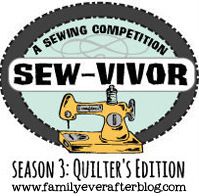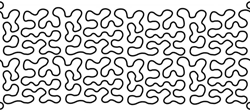Thanks to everyone for their kind feedback on my first post about renting a longarm. I wanted to begin this post by pointing out an important advantage to renting a longarm that I neglected to mention, but luckily
Hema commented: renting a longarm is very quick compared to what you can accomplish on your domestic machine or hand quilting. I once quilted three twin-sized quilts in one day at Laurena's - it was awesome!
To begin this post, I would like to explain the three different kinds of longarm quilting you can do when you rent a machine:
- Free Motion: Stand in front of the machine and do the quilting. You can use rulers, chalk, stencils, etc. to aid the quality and variety of your work
- Pantograph Pattern: Stand in back of the machine with a printed pattern laid out on the table, using a laser to follow the pattern on the paper. This will result in an all-over pattern on your quilt.
- Computerized Machine: Choose a digitized pattern that the machine will do on its own. You will be responsible for rolling the quilt, replacing the bobbin, and operating the software program. Lots of customization is possible with this option.
The first time I long-armed a quilt, I chose to try the Pantograph option. I hated it! It was so boring, I saw nothing enjoyable about guiding a laser repeatedly over some lines, and my work wasn't exactly stellar. I thought I would never come back to the longarm studio again.
Luckily I gave longarming another chance and I tried free motion quilting. I will admit that I stuck to stippling a lot:
I soon learned that I can stipple nicely enough and I definitely prefer looking at my quilt to staring at a tiny laser dot! Eventually, I ventured out to trying swirls and some free motion flowers. My free motion skills are far from Angela Walters quality but I know I need to practice (which is why I want my own longarm someday).
It wasn't until this last year or so that I finally discovered the "Statler Stitcher" (Gammill computerized longarm). I thought it was so fun to watch the big machine perfectly stitch out interesting patterns. It's definitely not as "hands on" as free-motion quilting but I am in love with the precision and thousands of possibilities available in the many available digital patterns. I've known of some people who do not enjoy "babysitting" a computerized machine and they feel too removed from the process. I can understand this and think this feeling is especially predominant among members of modern quilt guilds.
(hopefully you can see the amazing twist on the "Baptist Fan" that the Statler did on my quilt)
I would suggest that if you are able to do so and all of these options are available to you, go ahead and try all three types of longarm quilting and see what's best for you. I am so glad I didn't give up on longarming just because I didn't like doing a pantograph.
So if you are considering renting a longarm, here are a few tips and pieces of advice I have for you:
- Research all of your available rental options. Compare classes, prices, hours of operation, convenience, and go ahead and visit the studios. Get a feel for the "niceness" of the people who work there- I promise you don't want to quilt a quilt with someone you don't get along with.
- Decide on what type of quilting you are going to do for your quilt and do your "homework." If you are going to try free motion, doodle on whiteboards or scratch paper before you go. Look at free-motion quilting books and blogs to get ideas and practice drawing them or even doing them on a quilt sandwich on your home machine. If you're going to do a pantograph or digitized pattern, decide on that before you go. I once spent an hour picking a pattern and that was a big, unnecessary time eater.
- Dress comfortably and go healthy: this is when yoga pants and sneakers are okay outside of the gym. Reschedule if you're sick. Using a longarm is a physical process and you need to be prepared. If you're not feeling well, you aren't likely to produce your best work.
- Bring a lunch, water, and "something to do." Don't rely on local businesses for a lunch break unless you're positive they will be open. Having at least a snack and beverage available is important: you will probably spend a minimum of three hours there if you are doing a twin-sized quilt. I recommend bringing a book or hand sewing project along because there may be interruptions to your quilting, and you might find yourself waiting for help or a repair on the machine. It is especially possible to do something else if you are using a computerized machine- although I will admit that I liked to chat and watch the machine too much.
- Have a specific budget ready for your project: be generous with yourself on what you are prepared to spend. It's hard to predict how long you will be renting the longarm but you don't want to be in there feeling panicked that you can't afford what you are doing. This uncertainty could even effect the quality of your work if you are rushing to beat the clock. Talk to the person at the studio/store about what you can expect with rental times, batting, and thread costs.
- Most longarm rental places sell batting and can sell it to you by the inch- this option definitely cuts down on waste. They usually have quite a variety of types of batting. I almost always buy a queen sized package of Warm and Natural at Joann's for my projects because this is usually more economical but sometimes a 90 x 108 piece is not wide enough for very large quilts. You will have to make your decision based on your own preference and can probably research this before your longarm appointment.
Thanks for hanging in there with this long post. Let me know if you have any questions. I will be back soon with a newly completed quilt top to share. Thanks for reading.































